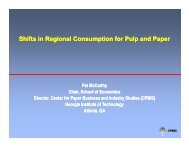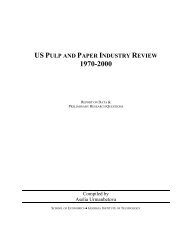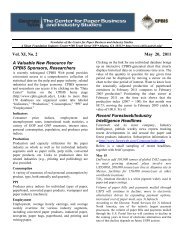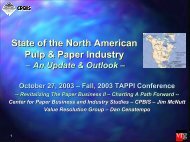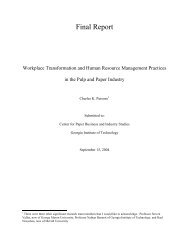equity carve-out (eco) - The Center for Paper Business and Industry ...
equity carve-out (eco) - The Center for Paper Business and Industry ...
equity carve-out (eco) - The Center for Paper Business and Industry ...
Create successful ePaper yourself
Turn your PDF publications into a flip-book with our unique Google optimized e-Paper software.
EQUITY CARVE-OUT (ECO) AS A FINANCIAL<br />
INSTRUMENT FOR CORPORATE RESTRUCTURING, WILL IT<br />
WORK FOR THE PULP AND PAPER INDUSTRY?<br />
V.R. (PERRY) PARTHASARATHY, PhD<br />
WEYERHAEUSER COMPANY<br />
PORT WENTWORTH, GA 31407<br />
2007 TAPPI Engineering, Pulping <strong>and</strong> Environmental Conference, Jacksonville, Florida, USA<br />
October 21 to 24, 2007
BREAKING UP IS GOOD TO DO.<br />
Restructuring through spin-offs <strong>and</strong> <strong>equity</strong> <strong>carve</strong>-<strong>out</strong>s can enhance<br />
Shareholder Value Creation (SVC)
o<br />
o<br />
o<br />
Restructuring usually eliminates diffusion of management goals, a<br />
problem that goes h<strong>and</strong> in h<strong>and</strong> with big, diversified companies.<br />
When the aim is to focus on being the best at one or two things,<br />
restructuring make sense.<br />
Spin-Offs (SO) <strong>and</strong> Equity Carve-Outs (ECO) are used by large<br />
corporations <strong>for</strong> restructuring purposes. Used judiciously, SO <strong>and</strong><br />
ECO are important financial instruments that help corporations<br />
increase value.
CORPORATE EQUITY CLAIMS<br />
<strong>The</strong>re are three types of corporate <strong>equity</strong> claims:<br />
o<br />
o<br />
o<br />
Tracking (or Targeted) Stock (TS),<br />
Majority-owned Equity Carve-Out (ECO) <strong>and</strong><br />
Spin-offs (SO).
CORPORATE EQUITY CLAIMS<br />
<strong>The</strong> Tracking Stock (TS) is a class of common stock that is linked to<br />
the per<strong>for</strong>mance of a specific business group within the diversified firm.<br />
Equity Carve-<strong>out</strong>s (ECO) are an IPO of a stake in a subsidiary. <strong>The</strong><br />
parent usually keeps majority ownership.<br />
Spin-offs (SO) occur when the entire ownership of a subsidiary is<br />
divested as a dividend to shareholders.
TRACKING STOCK (TS)<br />
o<br />
o<br />
o<br />
o<br />
<strong>The</strong> financial reporting is separate <strong>for</strong> the TS from the parent but the<br />
control remains in the h<strong>and</strong>s of the parent company.<br />
TS is typically distributed as a dividend to shareholders of the parent<br />
company <strong>and</strong> can also take the <strong>for</strong>m of an Initial Public Offering<br />
(IPO).<br />
Even during its hay day, only two Pulp <strong>and</strong> <strong>Paper</strong> Companies had<br />
taken advantage of this instrument but that did not result in the<br />
enhancement of their corporate value.<br />
By 2006, the TS as a corporate restructuring tool had disappeared<br />
altogether <strong>and</strong> none was issued between 2001 <strong>and</strong> 2006.
EQUITY CARVE-OUT (ECO)<br />
o<br />
o<br />
o<br />
o<br />
<strong>The</strong> ECO is different from TS in that <strong>equity</strong> partition creates welldefined<br />
<strong>equity</strong> claims on assets.<br />
ECO is the sale of a subsidiary by a publicly traded company by<br />
carving <strong>out</strong> a portion of its <strong>out</strong>st<strong>and</strong>ing shares through IPO.<br />
While the parent firm usually retains a controlling interest in the<br />
partitioned subsidiary, each ECO, however will have its own board,<br />
operating CEO, <strong>and</strong> will issue its own financial statement.<br />
Equity Carve-Outs (ECO) increase the access to capital markets,<br />
enabling ECO subsidiary strong growth opportunities while avoiding<br />
the negative signaling associated with a seasoned offering (SEO) of<br />
parent <strong>equity</strong>.
EQUITY CARVE-OUT (ECO)<br />
o<br />
o<br />
o<br />
In a twelve-year period between 1988 <strong>and</strong> 1999, the US stock market has seen 50 Carve<strong>out</strong>s,<br />
or ab<strong>out</strong> 10% of the IPOs issued.<br />
While the number of IPOs issued had increased at least three fold between the years<br />
1997 <strong>and</strong> 2006, the IPOs <strong>for</strong> ECO were not that many (Exhibit 1).<br />
Over the years, ECO as a corporate restructuring vehicle has shifted, <strong>for</strong> financial gain to<br />
strategic realignment.<br />
Percent<br />
Strategic<br />
Reasons<br />
Financial<br />
Reasons<br />
Strategic<br />
Reasons<br />
Financial<br />
Reasons<br />
EXHIBIT 1.<br />
<strong>The</strong> Trend in Asset<br />
Disaggregation<br />
Number<br />
of Events<br />
100%<br />
80%<br />
60%<br />
SPIN-OFF<br />
EQUITY CARVE-OUT (ECO)<br />
17 26 83 10 15 7<br />
88 50<br />
42<br />
80 44 25<br />
40%<br />
20%<br />
12<br />
50<br />
58<br />
80 20 44 56 25<br />
75<br />
1988-1993 1994-1996 1997-2006<br />
1988-1993 1994-1996<br />
1997-2006<br />
Source: Bloomberg, Financial Executives Research Foundation , Compustat Inc., Compustat SDC, BDCI SDC, Analysis<br />
BDCI Analysis
EQUITY CARVE-OUT (ECO)<br />
One thing sure ab<strong>out</strong> ECO is the inherent assumption that the asset that is being <strong>carve</strong>d-<strong>out</strong><br />
could not derive its full asset value under the existing corporate structure <strong>and</strong> a <strong>carve</strong>-<strong>out</strong> will<br />
accurately value the subsidiary if, part of the <strong>equity</strong> is <strong>carve</strong>d <strong>out</strong> <strong>and</strong> sold in an IPO (Exhibit 2).<br />
EXHIBIT 2.<br />
Equity Carve-Out<br />
(Pros <strong>and</strong> Cons)
EQUITY CARVE-OUT (ECO)<br />
o<br />
o<br />
Common <strong>equity</strong> is the cheapest yet the largest value distribution in the Enterprise<br />
Valuation of a company with multiple business segments.<br />
ECO gives a corporate parent an opportunity to get <strong>equity</strong> <strong>and</strong> at the same time<br />
increase its market capitalization by virtue of restructuring one of the units as a<br />
<strong>carve</strong>d-<strong>out</strong> entity<br />
TOTAL = 2000<br />
Convertible Securities<br />
200 250<br />
250<br />
Operation D<br />
Corporate<br />
Overhead<br />
1750<br />
*all values in million US$<br />
400<br />
Debt<br />
EXHIBIT 3.<br />
Valuation of an<br />
Enterprise with<br />
Multi-<strong>Business</strong><br />
Segments<br />
350<br />
Operation C<br />
450<br />
Operation B<br />
750*<br />
Operation A<br />
200<br />
1150<br />
Preferred<br />
Stock<br />
Common<br />
Equity Stock<br />
Value of the<br />
Enterprise<br />
Value<br />
Operating Units<br />
Value<br />
Distribution<br />
Source: “Valuation” – Measuring <strong>and</strong> Managing the Value of Companies: McKinsey & Company, Inc.,
EQUITY CARVE-OUT (ECO)<br />
o<br />
o<br />
<strong>The</strong>rmo-Electron (TE) is the most successful company to leverage ECO to deliver<br />
high returns to its shareholders.<br />
In 1982, TE was just a US $200 million company. By 1997, its market value was<br />
$5200 million (a whopping 2500%) through frequent <strong>equity</strong> partition of business<br />
segments <strong>and</strong> owning controlled interest in the ECO subsidiaries<br />
EXHIBIT 4.<br />
<strong>The</strong>rmo Electron’s<br />
ECO Examples
EQUITY CARVE-OUT (ECO)<br />
Equity Carve-Outs (ECO) <strong>out</strong> per<strong>for</strong>med SO on three financial metrics, Total Shareholder Return<br />
(TSR), change in leading P/E ratio <strong>and</strong> Return on Invested Capital (ROIC).<br />
EXHIBIT 5.<br />
Comparison of<br />
Per<strong>for</strong>mance<br />
Metrics <strong>for</strong> ECO<br />
<strong>and</strong> SO
EQUITY CARVE-OUT (ECO)<br />
<strong>The</strong> Booz-Allen & Hamilton <strong>and</strong> SMU/<strong>The</strong> McKinsey Company studies which<br />
compared 78 merger deals between 1997 <strong>and</strong> 1998 <strong>and</strong> between 2002 <strong>and</strong><br />
2003 <strong>and</strong> worth more than $1 billion each, concluded that<br />
o<br />
o<br />
o<br />
48% of the mergers failed to deliver the promised cost savings over<br />
the two-year post-merger period.<br />
52 percent of them had fallen short of achieving the revenue growth.<br />
Almost one-third of the companies delivered less than 40% of<br />
the cost-savings that were used as the basis <strong>for</strong> the mergers.<br />
<strong>The</strong> previous pulp <strong>and</strong> paper industry mergers (<strong>and</strong> the premiums<br />
paid to acquire the companies) had been justified under potential<br />
cost savings rather than revenue growth put a big dent on their<br />
chance <strong>for</strong> success which came <strong>out</strong> to be true.
Pre-Merger Revenue Growth<br />
EQUITY CARVE-OUT (ECO)<br />
ECO on average has the strongest TSR or SVC per<strong>for</strong>mance of any restructuring vehicle <strong>and</strong> the track<br />
r<strong>eco</strong>rd of ECO on ROIC are far superior to Spin-offs (SO).<br />
Positive<br />
Slow Down of<br />
Solid Per<strong>for</strong>mers<br />
4<br />
3<br />
Great Earners Unfazed<br />
2<br />
EXHIBIT 6.<br />
Very Few<br />
Companies<br />
Achieved Success<br />
Through Mergers<br />
1<br />
-2 -1<br />
0<br />
1<br />
2 3<br />
0<br />
-1<br />
-2<br />
Bad Remains Bad<br />
Negative<br />
-3<br />
Very Few Players Per<strong>for</strong>m<br />
Negative<br />
Post-Merger Revenue Growth<br />
Positive<br />
Sample of more than 160 acquisitions by 157 publicly traded companies across 11 industries. Revenue growth calculated <strong>for</strong> combined entity<br />
5 years be<strong>for</strong>e <strong>and</strong> after mergers (1996-2005)<br />
Source: <strong>The</strong> McKinsey Quarterly 2001, Number 4.
EQUITY CARVE-OUT (ECO)<br />
o<br />
o<br />
o<br />
To deliver superior shareholder return, P&P industry can use, ECO as a<br />
corporate restructuring vehicle.<br />
For ECO to be successful, the parent company should have multi-segmented<br />
businesses <strong>and</strong> that the subsidiary can be separated easily from the parent<br />
with<strong>out</strong> creating huge transfer-pricing issues <strong>and</strong> also the subsidiary should<br />
have good prospects.<br />
Out of the eighteen large U.S. <strong>and</strong> Canadian pulp <strong>and</strong> paper companies, only<br />
six are truly multi-segmented businesses <strong>and</strong> only these companies can do an<br />
ECO or spin-off.
EQUITY CARVE-OUT (ECO)<br />
<strong>The</strong> majority-owned ECO is the most appropriate <strong>for</strong> P&P industry<br />
because:<br />
Out of the six P&P companies that are truly multi-segmented businesses, five of them<br />
have debt to <strong>equity</strong> ratio over 1.5 <strong>and</strong> there<strong>for</strong>e suffer huge capital constraints.<br />
ECO will allow the parent companies to raise capital at a fair-price <strong>and</strong> to fund projects<br />
that might otherwise depress earnings.
EQUITY CARVE-OUT (ECO)<br />
<strong>The</strong> majority-owned ECO is the most appropriate <strong>for</strong> P&P industry<br />
because:<br />
Certain businesses in pulp <strong>and</strong> paper companies, woodl<strong>and</strong>s or lumber, <strong>for</strong> example, can<br />
readily be separated with<strong>out</strong> involving transfer price problems.<br />
Be<strong>for</strong>e the ECO, both the boards need to review contractual agreements, including those<br />
establishing transfer prices, <strong>and</strong> agree on sharing other supports such as R&D, sales<br />
<strong>and</strong> marketing, <strong>and</strong> certain manufacturing resources, etc.
EQUITY CARVE-OUT (ECO)<br />
CONCLUSIONS<br />
Restructuring of corporations is usually carried-<strong>out</strong> to improve<br />
per<strong>for</strong>mance.<br />
A majority-owned <strong>equity</strong> <strong>carve</strong>-<strong>out</strong> is one such <strong>equity</strong> claim that would<br />
allow the <strong>carve</strong>d-<strong>out</strong> business units to improve per<strong>for</strong>mance by<br />
exposing them to the capital market <strong>and</strong> attracting new investors.<br />
ECO brings a new management team into the organization. This usually<br />
results in improvement in operating per<strong>for</strong>mance, providing<br />
incentives <strong>for</strong> managers <strong>and</strong> increasing their strategic flexibility.
EQUITY CARVE-OUT (ECO)<br />
CONCLUSIONS<br />
While mergers can be used as one of the tools to improve the<br />
per<strong>for</strong>mance of the pulp <strong>and</strong> paper industry, <strong>for</strong> companies with<br />
multi-segmented businesses, the ECO offers the best valueenhancing<br />
proposition<br />
If judiciously applied, ECO can help corporate management to increase<br />
value of both the parent <strong>and</strong> the <strong>carve</strong>d-<strong>out</strong> subsidiary.
Thanks.



